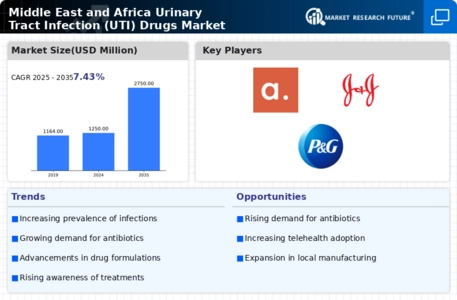Market Share
MEA UTI Drugs Market Share Analysis
Companies in the Middle East and Africa (MEA) Urinary Tract Infection (UTI) Drugs Market use different market share positioning strategies to get ahead of their competitors and increase their presence. A major strategy that firms employ is product differentiation where most pharmaceutical companies have specialized in developing unique UTI drugs. These firms aim at capturing a significant portion of the market by providing medicines with distinct characteristics such as improved efficacy or fewer side effects.
Strategic alliances and partnerships also play a critical role in determining the market share within MEA region. Many times, companies collaborate with healthcare providers, distributors or even other pharmaceutical companies to expand their coverage and distribution channels. This means that broader market access can be facilitated as well as introduction of UTI drugs to new demographics through such associations. Such collaborations are particularly valuable amidst the varied healthcare landscapes across the Middle East and Africa where regulatory environments differ widely along with patient demographics.
Pricing is another key strategic issue related to gaining market share penetration. Due to differing economic conditions across MEA region, pharmaceutical firms opt for specific pricing strategies for their UTI drugs aimed at affordability levels in various markets segments. By adopting flexible pricing models and providing price cuts or subsidies, companies can therefore reach a bigger pool of potential buyers thus increasing accessibility.
Apart from pricing, effective marketing and promotional activities go a long way in defining ones’ position in terms of market shares available. This is by creating awareness about UTI drugs through targeted adverts campaigns, medical conferences among others that educate people on what they do hence building brands which healthcare professionals can trust on plus consumers too. Consequently, companies that establish strong brand presence can influence prescription patterns leading into higher adoption of their UTI drugs within MEA market.
Equally important are continuous research & development efforts that help maintain competitive position in the MEA UTI Drugs Market scene. Pharmaceutical firms invest heavily into scientific breakthroughs plus clinical studies so as to enhance effectiveness of existing drugs or create new formulations that will be more potent. Such a strategy maintains organizational market position in addition to cementing its reputation as a trusted and progressive stakeholder within the UTI treatment landscape.
Furthermore, addressing regional variations and tailoring strategies to meet specific market needs is also critical for success in the MEA region. Cultural preferences, regulatory requirements and healthcare infrastructure could differ remarkably across nations. This makes it easier for firms that take account of such factors when customizing their marketing approach so as to manage challenges and exploit opportunities in diverse markets of MEA region.














Leave a Comment